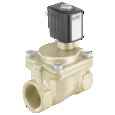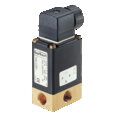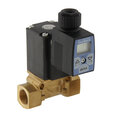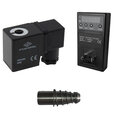Water Solenoid Valve
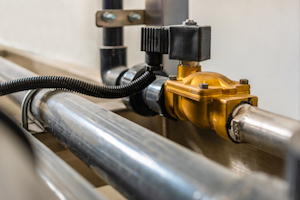
Figure 1: A solenoid valve controlling the release of water through a drinking water system.
Solenoid valves are often chosen to control water flow throughout residential, commercial, and industrial systems. They work well with filling tanks, controlling water flow in water treatment centers, filling washing machines, and much more.
This article overviews the criteria to consider when deciding which solenoid valve type to use with a water application. Read our solenoid valve overview article for further information on the designs and operation principles of various types of solenoid valves.
Water solenoid valve selection criteria
There are several factors to consider when selecting a solenoid valve for a water application, which this section expands upon:
View our online selection of solenoid valves and buy one today!
Valve body material
The body of a solenoid valve used in a water application will likely be stainless steel, brass, or PVC. Consider the following aspects when choosing between the materials:
- Temperature: PVC is suitable up to 60 °C (140 °F). Stainless steel and brass are suitable for significantly higher temperatures, however, for the valve's rated temperature range, the seal material also needs to be taken into account (see below).
- Pressure: PVC valves operate up to 20 bar (300 psi), brass valves operate up to 41 bar (600 psi), and stainless steel valves operate up to 103 bar (1500 psi). A valve's precise pressure rating can vary among manufacturers.
- Corrosive chemicals: Stainless steel is suitable for more chemicals than brass and PVC. Therefore, brass and PVC will likely be unsuitable for water that contains or may contain corrosive chemicals.
- Hydraulic shock: Stainless steel is more resistant to hydraulic shocks in the system, such as water hammer, than brass and PVC.
Valve seal material
There are a variety of materials used to produce seals for solenoid valves. However, NBR and EPDM seals are the most widely used in water applications.
- NBR: NBR is suitable for general applications. It is safely used up to 60 °C (140 °F), sometimes 80 °C (176 °F). It's max pressure rating is 17 bar (250 psi).
- EPDM: EPDM is commonly chosen for drinking water applications because it does not have a noticeable effect on the water's taste. It is safely used up to 150 °C (302 °F). It's max pressure rating is 24 bar (350 psi).
For applications with media at temperatures above 150 °C, it's advised to use a steam valve.
Valve design
2/2-way and 3/2-way solenoid valves are used in water applications.
- 2/2-way: 2/2-way solenoid valves are selected for on/off water control applications.
- 3/2-way: 3/2-way solenoid valves are selected for more precise control, such as controlling water supply to different zones in irrigation systems and switching between different sources in water treatment systems.
Water applications use direct, semi-direct, and indirect acting solenoid valves. For applications that require fast valve response at 0 bar, choose a direct-acting solenoid valve. Conversely, for applications with high flow rates and pressure, choose an indirect solenoid valve.
Flow rate
Given the same size, solenoid valve designs have the most to least flow rate in the following order: indirect, semi-direct, and direct. It's necessary to know an application's desired flow rate before selecting a valve to ensure the chosen valve is not oversized or undersized.
- Oversized: Oversized valves are more expensive than the application requires. Also, indirect solenoid valves will cycle on and off unnecessarily. If the flow's pressure is not high enough to hold open the oversized valve, it will suddenly close. This causes the pressure differential to equilibrate, once again opening the valve to continue this cycle.
- Undersized: The application's flow rate will not be met.
For more information, refer to our valve sizing calculator.
Water quality
In hard water systems, lime scale can build up in a solenoid valve, causing it to operate incorrectly or preventing it from closing. AC solenoid valves can be held in a powered state, overheat, and break in this scenario, whereas DC solenoid valves will not. To mitigate damage to a solenoid valve in a hard water system:
- Latching valves: A latching valve is a special type of solenoid that changes state (open or closed) when power is supplied to the valve. It cannot be held in a powered state, which risks overheating.
- Water softener: Water softeners can be installed upstream of the solenoid valve, preventing hard water from damaging said valve.
Cost
At small sizes (12.7 mm or 1/2 inch or less), direct-acting solenoid valves are the most cost-effective. At larger sizes, direct-acting solenoid valves require larger and larger solenoids to operate effectively, making them less cost-effective than their semi-direct and indirect counterparts.




